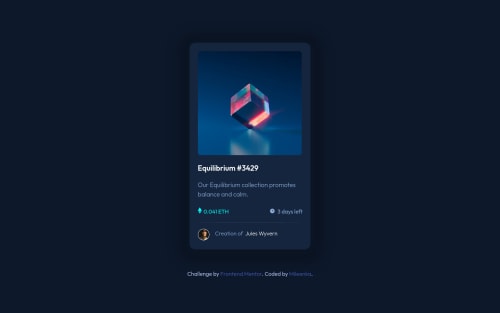NFT preview card component

Please log in to post a comment
Log in with GitHubCommunity feedback
- @correlucas
👾Hello @Mileenka, Congratulations on completing this challenge!
Nice code and nice solution! You did a good job here putting everything together. I’ve some suggestions for you:
1.Add transitions to make the interaction smoother while the element gets hovered, you can use a value like
transition: all ease-in 0.5s.2.Add a margin of around
margin: 20pxto avoid the card touching the screen edges while it scales down.3.Use units as
remoreminstead ofpxto improve your performance by resizing fonts between different screens and devices.To save your time you can code your whole page using
pxand then in the end use a VsCode plugin called px to rem here's the link → https://marketplace.visualstudio.com/items?itemName=sainoba.px-to-rem to do the automatic conversion or use this website https://pixelsconverter.com/px-to-rem✌️ I hope this helps you and happy coding!
Marked as helpful - @IDev11
Hey Mileenka, how are you doing?
Your solution is excellent, I like it!
But I have some few tips that might help :
1- the square width and height needs to be 300px so that it can cover the whole image when you hover over it.
2- You can use relative units as rem or em that have a better fit if you want your site more accessible between different screen sizes and devices. REM and EM does not just apply to font size, but to all sizes as well, check this video from Kevin Powell https://youtu.be/N5wpD9Ov_To
The rest is great! Happy coding.
Marked as helpful
Join our Discord community
Join thousands of Frontend Mentor community members taking the challenges, sharing resources, helping each other, and chatting about all things front-end!
Join our Discord